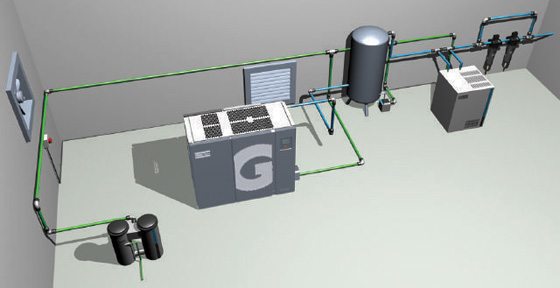A powdery substance made with calcined lime and clay, cement is a vital material used in a wide variety of construction and infrastructure projects from building foundations and masonry work to tunnels, roads and bridges. Compressed air is often required during the cement manufacturing process for plant and instrument air, pneumatic conveyors and for aeration in cement silos.
In order to meet its commitment to quality and the demands of its nation’s efforts toward infrastructure development, one large cement manufacturer located in Oman designed a compressed air system that meets global standards, including ISO 9001 and ISO 14001 certifications for quality, environmental management and performance.
Creating an Energy-Efficient Compressed Air Mix
The cement plant operates 16 oil-injected screw compressors throughout the plant, and several feature variable speed drive (VSD) technology. VSDs allow you to match the speed of the motor-driven equipment to the load requirement. Atlas Copco’s GA compressors incorporate state-of-the-art compression elements based on innovative asymmetric rotor profiles, a high-quality drive system and heavy-duty air inlet filters. All these components are selected to operate continuously in the toughest conditions and at ambient temperatures up to 55°C/131°F while reducing energy costs by 35 percent on average.
In the harsh and dusty environment of a cement plant, two oil-free, single-stage compressors feature an integrated variable speed drive, screw technology, stainless steel coolers and a state-of-the art electrical drive system, all of which contribute to the production of a reliable supply of pure air at minimal energy costs.
Dusty environment? Consider a dedicated compressor room.
Cement plants are harsh and dusty environments and can cause problems for air-cooled compressors. To solve this issue, the cement manufacturer constructed a dedicated compressor room with dual filtration screens. With a dedicated compressor room, the oil-free screw blowers that are used in the aeration applications are protected from the harsh environment and can continually operate at the highest performance.
Screw blowers utilize the screw compression element, consisting of male and female rotors that rotate in opposite directions while the volume between the rotors and the housing decreases. Each screw element has a fixed, built-in pressure ratio and has no mechanical forces that cause unbalance. This means the screw technology can work at a high shaft speed and combine a large flow rate with small exterior dimensions, resulting in energy savings of up to 30 percent compared to lobe type blowers.
How to Save 30 Percent on Energy Costs
If you’d like to learn more about how your facility can save energy costs by upgrading to more efficient equipment and implementing strategies to reduce maintenance, contact us by filling out our Request a Quote form and a representative will be in touch with you shortly. You may also enjoy the following articles:
- Understanding Variable Frequency Drives, Part III
- Detergent Manufacturer Utilizes VSD Technology for Major Energy Savings
- How to Eliminate Risks to Compressed Air Purity in Food Applications
Source: Compressed Air Blog


